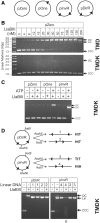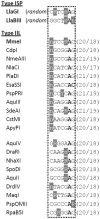The Type ISP Restriction-Modification enzymes LlaBIII and LlaGI use a translocation-collision mechanism to cleave non-specific DNA distant from their recognition sites
- PMID: 23222132
- PMCID: PMC3553950
- DOI: 10.1093/nar/gks1209
The Type ISP Restriction-Modification enzymes LlaBIII and LlaGI use a translocation-collision mechanism to cleave non-specific DNA distant from their recognition sites
Abstract
The Type ISP Restriction-Modification (RM) enzyme LlaBIII is encoded on plasmid pJW566 and can protect Lactococcus lactis strains against bacteriophage infections in milk fermentations. It is a single polypeptide RM enzyme comprising Mrr endonuclease, DNA helicase, adenine methyltransferase and target-recognition domains. LlaBIII shares >95% amino acid sequence homology across its first three protein domains with the Type ISP enzyme LlaGI. Here, we determine the recognition sequence of LlaBIII (5'-TnAGCC-3', where the adenine complementary to the underlined base is methylated), and characterize its enzyme activities. LlaBIII shares key enzymatic features with LlaGI; namely, adenosine triphosphate-dependent DNA translocation (∼309 bp/s at 25°C) and a requirement for DNA cleavage of two recognition sites in an inverted head-to-head repeat. However, LlaBIII requires K(+) ions to prevent non-specific DNA cleavage, conditions which affect the translocation and cleavage properties of LlaGI. By identifying the locations of the non-specific dsDNA breaks introduced by LlaGI or LlaBIII under different buffer conditions, we validate that the Type ISP RM enzymes use a common translocation-collision mechanism to trigger endonuclease activity. In their favoured in vitro buffer, both LlaGI and LlaBIII produce a normal distribution of random cleavage loci centred midway between the sites. In contrast, LlaGI in K(+) ions produces a far more distributive cleavage profile.
Figures






References
Publication types
MeSH terms
Substances
Grants and funding
LinkOut - more resources
Full Text Sources
Molecular Biology Databases

